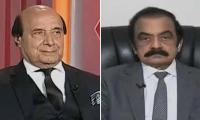One way to see the economic crisis that has claimed Asad Umar as its first ministerial victim is as the product of two simultaneous deficits. There are too few taxes whilst expenditures are growing. This is the fiscal deficit. There are too few exports whilst imports have been growing. This is the current account deficit. So Pakistani deficit hawks are not wrong: the country has a problem of too few taxes and too few exports.
So what is the solution that Pakistan’s surplus of retired IMF, World Bank and UN bureaucrats and Musharraf-era economists come up with for too little money flowing in, and too much flowing out? They say (and they always say this): reduce spending, decrease your imports. In short, pull the handbrake. This, in a nutshell, is the ‘austerity’ that PTI supporters were sold as a solution to the economic crisis that was bequeathed, at least in part, to Prime Minister Imran Khan, by the previous government.
The current state of the economy, however, is not solely the work of the previous government. Despite leaving behind a growing economy, the PML-N did two things as it exited the scene that helped exacerbate the crisis. The first was to leave behind no plan to manage the fiscal crisis that it created, and indeed exacerbated with its first non-Ishaq Dar, but final overall budget.
The second was to appoint Shamshad Akhtar, a deficit hawk if there ever was one, as the caretaker finance minister. The caretaker finance minister spent a few weeks going through the national accounts and discovered that there were more expenditures than there were receipts. She then essentially used her own judgement to substantially reduce the Public Sector Development Programme (PSDP) which is the Pakistani state’s annual statement of intent to expand its capacity to serve the people. No one bothered to ask whether caretakers should be making such massive judgement calls. No one bothered because for a year in advance of the elections, the national media, and the wider security establishment evolved a unison about the twin deficits: it was causing a ballooning of the external debt and it had to be stopped.
When Prime Minister Khan and the PTI took office, they had spent the better part of two decades with a single-point governance agenda: corruption is the root of all evil in Pakistan. This single point is so central to the PTI ethos that even today, as Firdous Ashiq Awan, Sheikh Rashid and Brigadier Ijaz Shah step triumphantly around the carcasses of any kind of moral authority old-school Insafians ever had, PTI supporters continue to insist that Imran Khan’s personal lack of financial corruption will help solve Pakistan’s various crises. Indeed, this was the economic model that the PTI brought to the PM Office and the federal secretariat. As it turns out, this is no model at all. Thrown in the deep end with little preparation, Asad Umar was expected to manage three crises: not a single one of which was of his making.
The first crisis was, of course, the twin deficits left behind by the PML-N. The second crisis was the economic slowdown that was guaranteed by the indefensible austerity that was imposed on the PTI government by a caretaker setup that had no legitimacy to make such a serious and important call. The third crisis was the burden of expectations and contradictions that brain-dead cheerleaders of the current government have helped hype to levels that cannot be climbed down from.
Take a look at what this government is supposed to be able to manage, fiscally: One, a fully-funded national security regime. Two, a fully-funded social services regime. Three, a plethora of sweetheart deals for already super-rich friends of Imran Khan, like commerce czar Razzak Dawood and almost-energy czar Nadeem Babar. And four, no new taxes on the super rich friends of Imran Khan, like Jahangir Tareen, Aqeel Kareem Dhedhi and the rest of the Pakistan Stock Exchange behemoths that don’t like taxes.
Amidst all this, how exactly will Abdul Hafeez Shaikh rescue Pakistan? He will not. The best he can do is to make sure none of his wealthy friends are made uncomfortable. This means that soft amnesty schemes and even softer benami schemes will protect the un-taxed or lowly-taxed super rich. It means that there will be lots more withholding taxes, consumption taxes and transaction taxes – even if they are packaged as several VATs, or even a single VAT – to further tax the poor and the middle class. It means that austerity will take on a whole new level with even lower levels of PSDP and ADP allocations than what was imagined at this stage a year ago.
In return, the seths will set the stock exchange abuzz with some gains through the summer. Over time, the new fiscal straitjacket that the IMF and Abdul Hafeez Shaikh are fitting Pakistanis for may even help stabilize the macroeconomic vitals. But in this bargain Pakistan, which had since 2008, very painstakingly taken steps toward recovery from the dark Musharraf era of mistakes, will be plunged into a new era of low growth.
Low growth means an absence of jobs, and a steady corrosion of young people’s self confidence as the Washington-consensus and the Pakistani super rich combine to manage a series of inflationary strikes into their homes, and their hearts (these are millennial heads of households, and Gen Z first-time job-seekers, after all).
A lot of Insafians are going to be so sickened by the failure of their handsome and honest prime minister that they will disengage altogether from the political discourse. Many others will become even more radicalized – believing as so many PPP jiyalas began to believe in the 1990s about Shaheed Mohtarma Benazir Bhutto, in the other-worldly merits of their chosen messiah. Like Kaptaan, Raani too was just too good for the rotten place and time that she was born to serve in. The journeys of those jiyalas, at least in many voting booths in parts of Punjab, ended in voting for the PTI in 2013 and 2018. Where will the disillusioned Insafian voter go in 2036 or 2041? It will be fascinating to watch. But these voters will find a new home. They always do.
The more worrying parts of the country will continue to be ignored at great peril. Pakistan’s post conflict millennials and Generation Z youngsters don’t live in Okara, or Jacobabad, or Attock. They live in Peshawar, Orakzai, Swat and Waziristan. They live in Awaran, Quetta and Turbat. Many of them adopted Imran Khan as a symbol of change. They did not sign up for the circus in Islamabad that has been enacted in their name.
The young voter in Punjab never really adopted the PTI as a way of life. The PML-N’s stellar record of delivery in Punjab, no matter what you have been led to believe, is why it won entire districts, and retains a numerical strength that is within striking distance of a razor-thin majority in the Punjab Assembly. This means that the PTI’s failure in Punjab doesn’t hurt Pakistani democracy. But failure in post-normalization and post-integration Khyber Pakhtunkhwa, and continued failure in engineered Balochistan does hurt Pakistan, and Pakistani democracy. How?
Because it confirms the narrative that Pakistan’s enemies have been trying to sell to our young men and women in those provinces: “your problems don’t matter to the people running Pakistan. Your schools, your roads, your tap water, your clinics and hospitals: they do not matter. You can’t have nice metros, or nice malls, or nice jobs. You can’t drive nice cars. When there is an economic crisis, the state’s intent to expand its capacity in YOUR home districts will be the first to be sacrificed. You don’t matter.”
The economy isn’t an abstraction. It has real consequences beyond the headlines and beyond the volume of trade at the stock exchange. The path of austerity set by unimaginative friends of the super rich has real consequences for the non-rich in faraway places in this country. PM Khan knows this. He needed reformists to enact policies that solve such problems, not retired bureaucrats that only know how to exacerbate them.
The writer is an analyst and commentator.
Pakistan’s score on democracy index remains above 4 since 2008
Authorities increasingly use broad and sweeping measures to curb internet in face of political crises
President Xi calls upon countries of Global South to “support each other in taking the path to moderniaation”
Professional, modern military confronts problems by thinking along lines of its ends, ways, and means
Region has been in turmoil since 2022 with people demanding flour subsidies similar to those provided in GB
Analysts noted that unipolar order persists while new multipolar paradigm remains nascent







